Brassica oleracea var. gongylodes
I’m not sure if it’s my German heritage or my affection for oddball vegetables, but I feel drawn to growing kohlrabi.
This cabbage relative is quirky, forming a bulbous mass that resembles a purple or light green turnip but grows above ground.
It sprouts stems that look a little like antennae, topped with leaves similar to those of collards or broccoli.
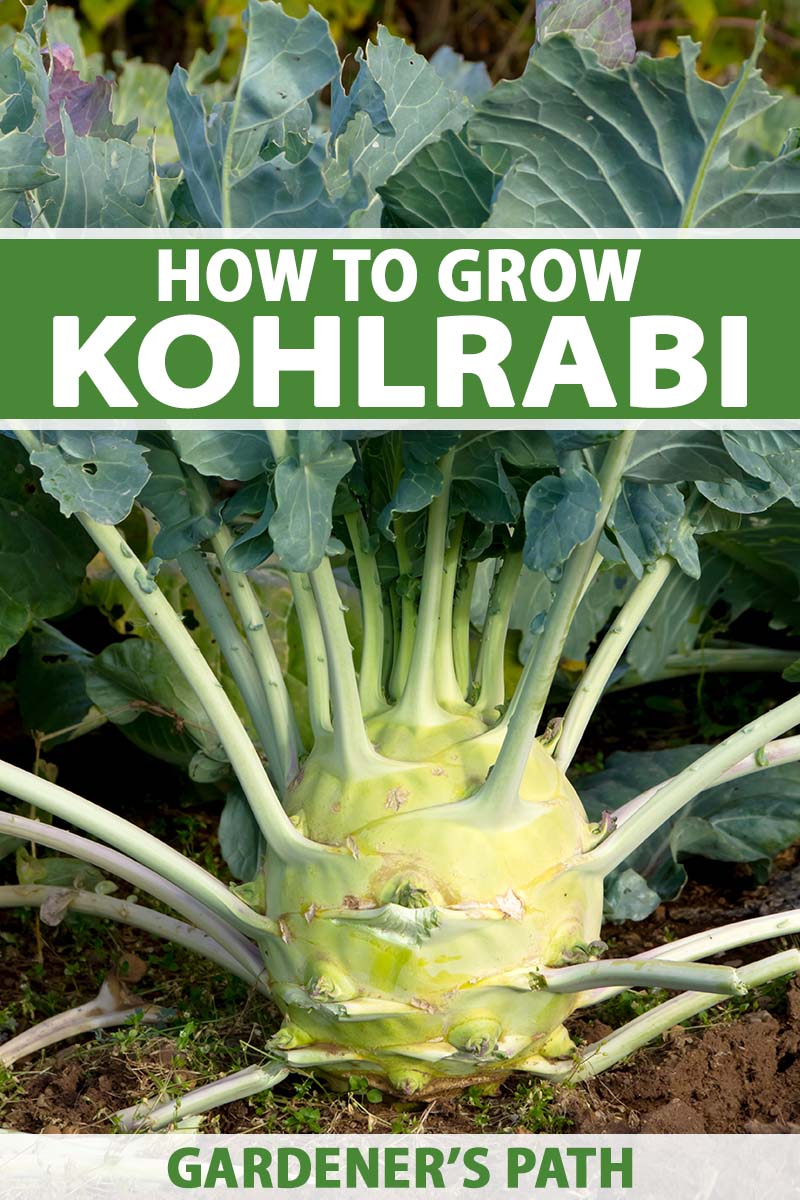
We link to vendors to help you find relevant products. If you buy from one of our links, we may earn a commission.
With most of us gardeners more accustomed to globe-shaped root vegetables, broccoli “trees,” or leafy bunches of kale, kohlrabi is one bizarre cruciferous veggie.
Some call it ugly, while others find it so pretty they use its striking colors and distinctive shape to liven up edible landscaping or cool-weather dish gardens.
I prize this offbeat vegetable for its flavor and its fast-growing nature. The dense white flesh inside those enlarged stems is crisp, sweet, and slightly turnipy. The best comparison I’ve heard is that it tastes a bit like broccoli stems.
The plants mature 45 to 70 days from sowing, depending on the variety, and produce edible greens in about 21 days. What’s not to love?
If you’re intrigued or already sold on the idea of growing kohlrabi in the home garden, I have lots of info for you. Here’s what’s coming up:
What You’ll Learn
What Is Kohlrabi?
Kohlrabi looks like a few things it’s not.
To start with, its edible portion appears to be a large bulb but is actually an enlarged stem, or stem globe, that grows above ground.
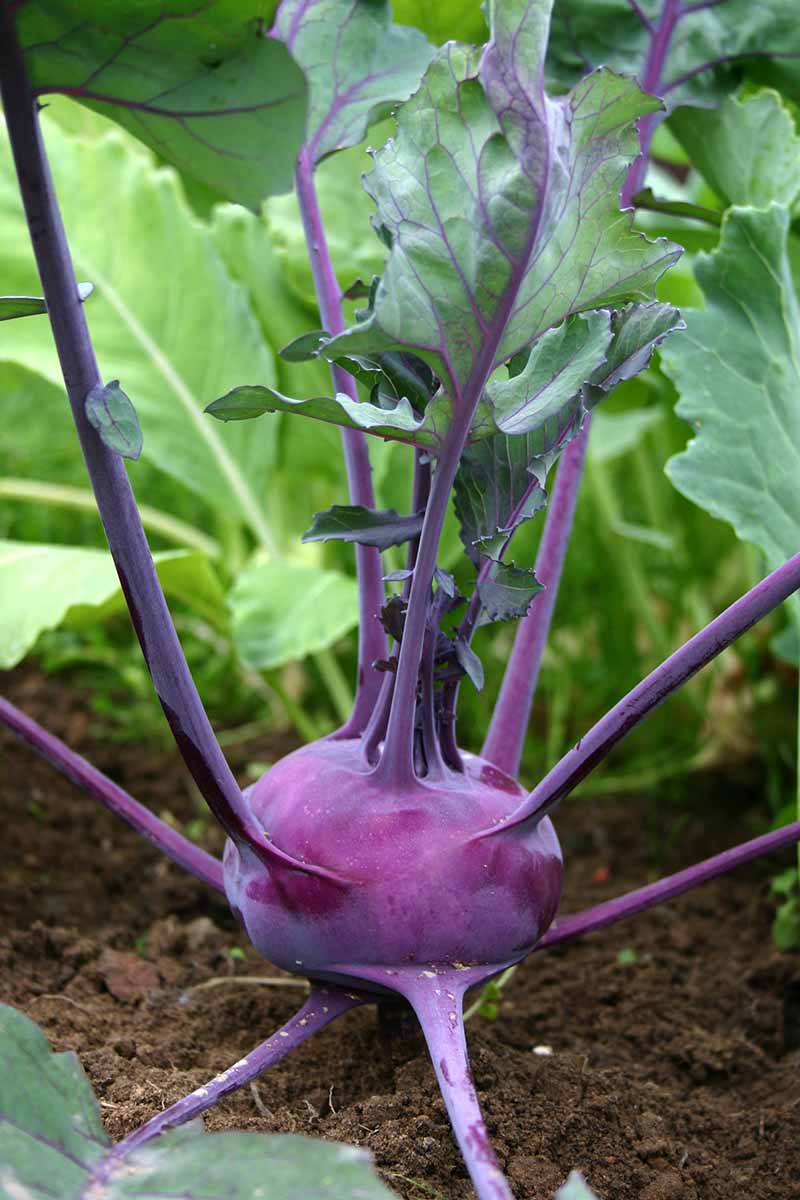
It’s okay to call them bulbs, everyone will know what you mean. But these are not true bulbs like daffodils, amaryllis, onions, and such.
With its purple or light green skin and protruding spiky stems of the same color, you may think it’s merely an alluring ornamental that a gardener would grow on a lark.
But those bulbous masses contain firm, white flesh with an apple texture and mild turnip taste. They’re delicious raw or cooked and are a reliable source of early spring or autumn produce.
Except for the young leaves, this cole crop looks nothing like brussels sprouts, cabbage, collards, kale, or broccoli. Yet all of these are actually the same species, Brassica oleracea, each derived from a wild mustard plant bred in different ways over the course of centuries.
Kohlrabi goes by the varietal name gongylodes, and its many cultivars may be referred to as belonging to the gongylodes group.
Do you agree with all the people who think those alien-looking spikes and globular growths make kohlrabi look like Sputnik? I’ll let you consider your answer while we discuss a few other traits.
The plants can grow nine to 18 inches tall and spread six to 18 inches wide, depending on the cultivar.
The enlarged stems that resemble bulbs may broaden to six to 10 inches as they mature, though all but the jumbo varieties are only crisp and edible when harvested at one to three inches wide.
Kohlrabi is most often grown as an annual, but it is actually a biennial, completing its life cycle by flowering and producing seeds in its second season.
Most of us vegetable gardeners wouldn’t be interested in leaving kohlrabi in the garden over the winter, though. The thickened stems only taste good when you harvest them at their peak, which is anywhere from 45 to 70 days from sowing, depending on the variety.
Planted in late summer or early fall as recommended, they’d become fibrous with a hot taste by November or December and would certainly be inedible by New Year’s.
There’s no point in allowing mature kohlrabi plants to take up space in the veggie garden that could be better given to a winter cabbage or cover crop – unless you want to let it overwinter outside to bloom the following spring, so you’ll have seeds to save for a new crop.
If you plan to save seeds, reserve only a couple of plants. They can yield hundreds of seeds apiece. But remember that a biennial brassica allowed to overwinter can potentially encourage soilborne diseases or overwintering bugs such as aphids.
In addition to its sweet, mild taste, kohlrabi is also high in fiber and essential nutrients like vitamin C and B6. And its leaves are delicious too. Small ones harvested young taste the best.
You’ll find more ideas for ways to serve kohlrabi coming up, but first, let’s look at the history of this offbeat cool-weather vegetable.
Cultivation and History
What’s even more unusual than the Sputnik shape or purple exterior of this vegetable is the fact that kohlrabi was unknown – no one had referred to it in writing – up until about 500 years ago.
Some other members of this same species are ancient vegetables, like the cabbage that was cultivated by the ancient Romans or the collard greens grown by ancient Greeks.

This particular B. oleracea variety was first recorded in northern Europe in 1554, when the botanist Matthiolus sketched it and wrote that it had “come lately into Italy.”
By the end of the 16th century, one could find kohlrabi being grown in England, Spain, Tripoli, and the Eastern Mediterranean.
At the same time, it gained popularity with Germans in particular. It takes its name from the German “Kohl,” which means “cabbage,” and “Rabi,” considered a variant of the Swiss German “Rübe,” or turnip.
Thus our stout, dense, bulbous brassica friend is called kohlrabi, aka German turnip.
Germany is responsible for producing and consuming the most kohlrabi worldwide today, and you’ll often find it steamed or sauteed and served with a white sauce made with lots of butter and cream, and spiced with nutmeg.
Folks in other countries grow and eat plenty, too, including gardeners and cooks in Austria, Switzerland, Vietnam, and the US. No one’s sure how it first made its way to the States, though records of its presence here date back to the early 19th century.
Want to join in on the fun? Here’s what you need to know about starting your own crop of tasty German turnips:
Kohlrabi Propagation
Kohlrabi is easy to grow from seed, although in some areas you may want to start seeds indoors so they can mature before the weather gets too hot.
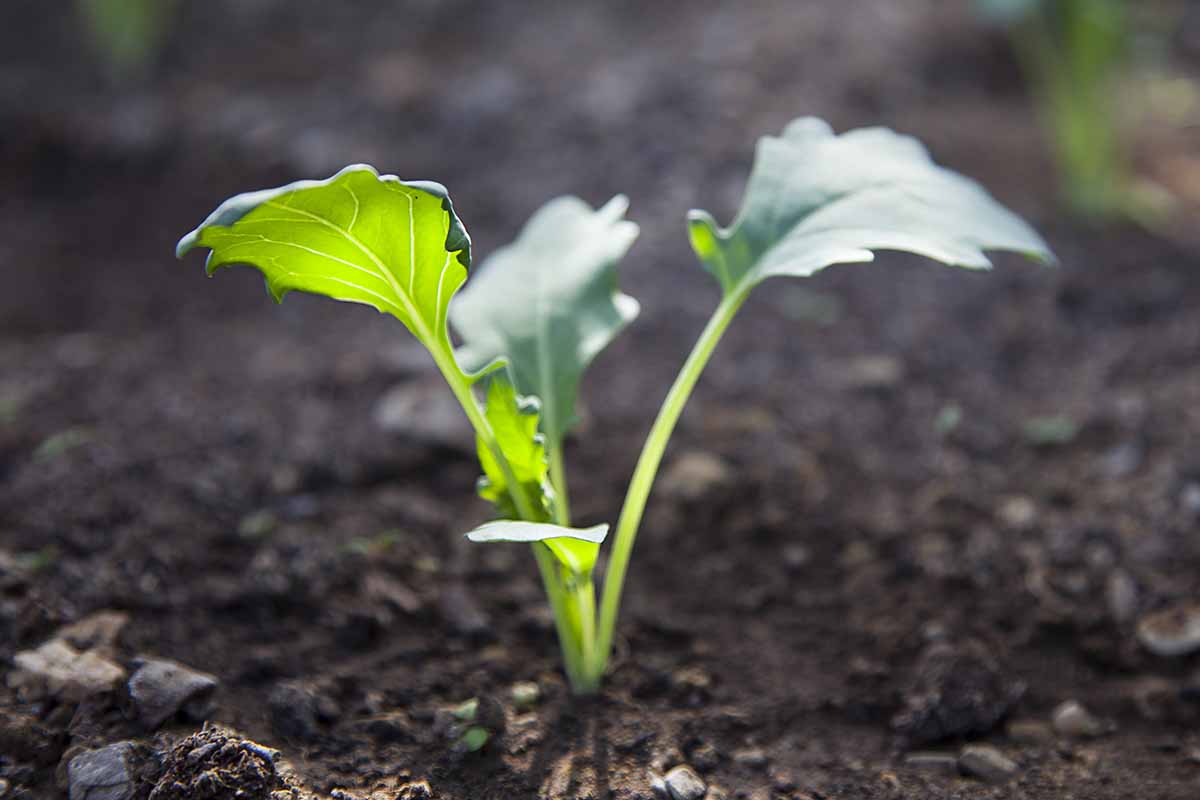
You can sometimes find starts locally, too, and transplant them into the garden. Here are the basics:
From Seed
In late winter or early spring, sow seeds as soon as the soil can be cultivated – usually two to four weeks ahead of the average last frost date in your area.
Plant seeds a half-inch deep, spacing them four inches apart, or 10 inches for jumbo varieties, with rows that are about a foot apart.
Or you can take the same tack as “The Victory Garden Cookbook” author Marian Morash.
She writes about sowing several seeds at four-inch intervals and then thinning the ones that sprout to leave only the strongest seedling in each spot.

The Victory Garden Cookbook, available on Amazon
Keep the soil moist – but not waterlogged – until the seeds sprout.
Plan to sow again, or succession plant, in late summer or early fall for an autumn or early winter harvest.
Our guide to planting kohlrabi from seed has complete info.
Especially if you live in an area where cool spring weather gives way to summer temperatures quickly, you may want to start seeds indoors so you can transplant young seedlings instead of direct sowing.
That will give you a couple of extra weeks for the kohlrabi to grow in the cool temperatures it prefers.
Sow seeds inside six to eight weeks ahead of the average last frost in your area, and you should have transplants ready to go in the ground a couple of weeks before the last frost.
You can sow indoors in midsummer, too, so you’ll have established seedlings ready for fall planting.
To minimize any root disturbance when you transplant, consider sowing in biodegradable pots that can be buried when they move outdoors.
CowPots are my favorite biodegradable option. Made from cow manure, they don’t include peat and will give the soil a nutrition boost once they deteriorate in your veggie patch.
CowPots Biodegradable Seed Starting Trays
Six-cell CowPot trays are available from Gardener’s Supply Company.
Transplanting
Whether you’ve grown or purchased starts, to avoid transplant shock, be sure to allow an extra week to gradually expose the seedlings to increased light and cooler temperatures outdoors.
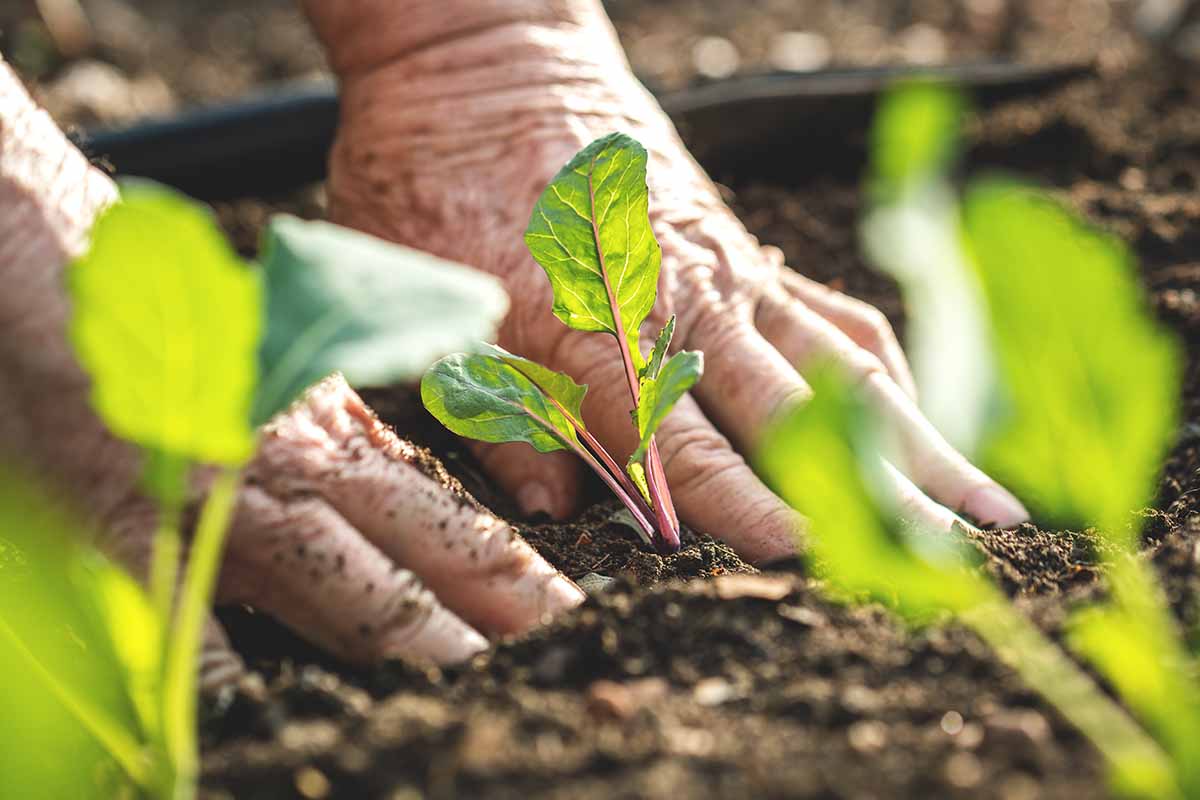
Plant out your hardened off seedlings as soon as the soil can be worked in spring, or in late summer to mid-fall for an autumn or early winter harvest.
How to Grow Kohlrabi
Kohlrabi is not a picky plant, but it does have a few non-negotiable growing requirements.
The first is a full-sun growing site, and the second is cool weather.
Though it grows quickly and produces the tastiest “bulbs” between 65 and 75°F, once temperatures exceed 75°F, this brassica will stop growing.
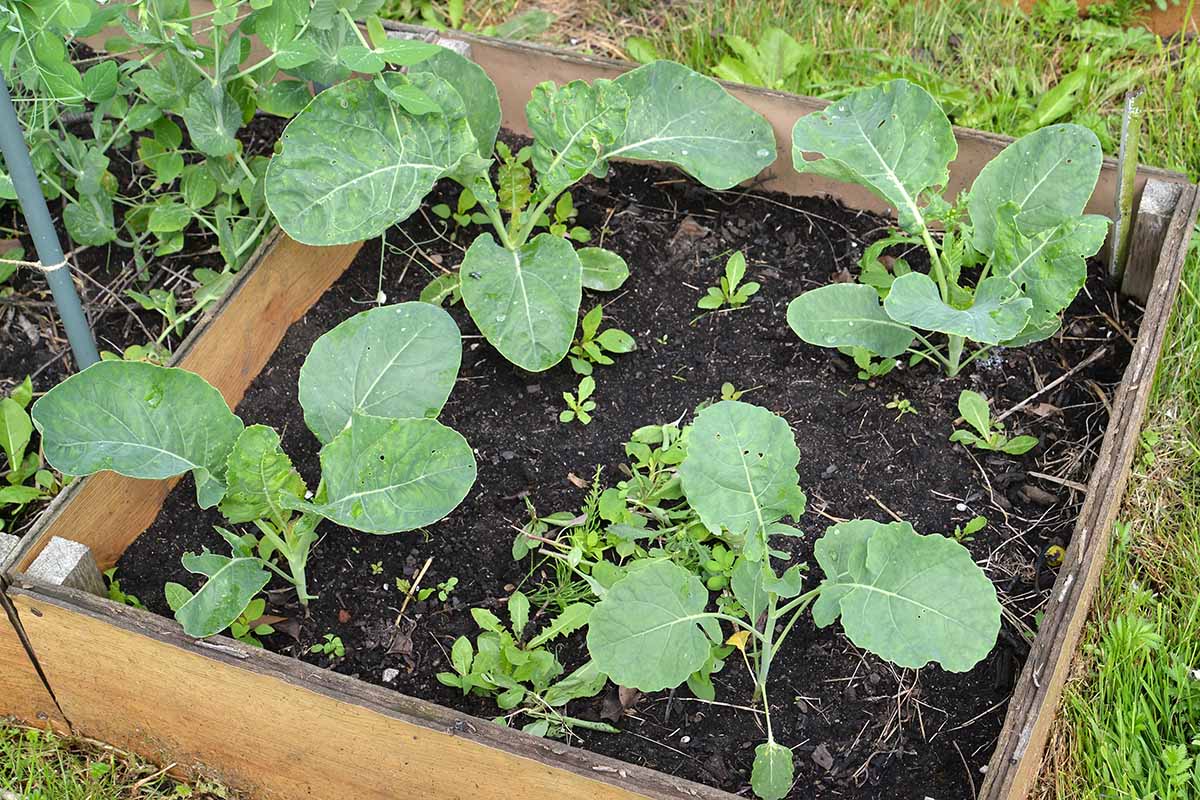
Hardy in Zones 3 to 9, those of us in warmer climates must ensure that it’s not subjected to more than a few days of temperatures above 75°F. A week or more of summery weather, and you can say goodbye to your crisp, broccoli-stem flavored crop.
Sow or transplant kohlrabi in late winter or early spring, or perhaps late summer or early fall, depending on your location – any time when it will enjoy cool weather for about 45 to 60 days.
On the other end of the thermometer, kohlrabi is said to taste sweeter after a few light frosts. Like other hardy cole crops, it can withstand freezes of 24 to 28°F.
Plant in rich, well-draining soil that’s been amended with plenty of aged manure or other composted organic material. Kohlrabi plants are heavy feeders that don’t appreciate wet feet.
Garden soil should have a slightly acidic to neutral pH of 6.0 to 7.0. Do a soil test beforehand, ideally the season before you intend to plant kohlrabi so you’ll have time to amend the soil to adjust the pH if needed.
If you can’t balance your native soil before it’s time to plant, consider trying a raised bed full of growing mix formulated for vegetables for a season.
If you’re growing kohlrabi in a container, it should have drainage holes and hold at least five gallons for four or five plants.
Once the seedlings or transplants are a few inches tall, measure rainfall with a rain gauge. If your kohlrabi isn’t receiving about two inches of total rain each week, provide supplemental water.
With a hose or watering can, water at the soil surface, not from above, to avoid transmitting waterborne diseases.
Throughout the growing season, continue to weed so these heavy-feeding cole crops won’t have to compete for nutrition.
A two-inch layer of untreated mulch like grass clippings or pine straw will help suppress weeds while it retains moisture.
Just ensure the mulch doesn’t touch the stems or leaves so it can’t transmit harmful water molds or soilborne fungi and bacteria.
Especially when you’re growing one of the varieties that take 55 or more days to mature, consider applying an 8-8-8 or 10-10-10 NPK all-purpose fertilizer when you sow or transplant.
Apply a side dressing of the same stuff once seedlings are a few weeks old or transplants have been in the ground for 30 days. Varieties bred to mature in 40 to 45 days can usually do without the extra fertilizer.
You won’t have to work too hard to keep up with kohlrabi for the six to eight weeks it requires to mature, but you should try to harvest before the bulbous stems get woody.
Growing Tips
- Sow seeds or transplant starts outdoors 2-4 weeks ahead of the average last frost date.
- Plant in full sun and well-draining soil.
- Mulch when the plants are a few inches high to suppress weeds and retain moisture.
Kohlrabi Cultivars to Select
Whether this is the first time you’ll grow this zany-looking vegetable or you’re looking for a new type you’ve never grown before, you’ll encounter a healthy number of choices.
Here are a few of my favorite cultivars:
Early White Vienna
Impatient for a spring or summer-planted harvest? ‘Early White Vienna’ is not as quick to mature as some hybrids like ‘Konan,’ but the bulbs are ready 55 days from sowing.
That’s early for an heirloom cultivar that dates back to the 19th century.
‘Early White Vienna’ has crisp, juicy flesh best consumed when the bulbs are two or three inches in diameter. Any older and they become woody.
‘Early White Vienna’ kohlrabi is delicious when peeled and cut into thin slices to serve raw with a favorite dip, or spiralized for a slaw.
You can find seeds available at True Leaf Market.
Konan
There is nothing barbaric about this ‘Konan!’
A 2016 All-America Selections winner in the edibles category, this hybrid produces four- to six-inch pale green bulbs with a sweet, slightly turnipy flavor.
Ready to harvest in just 45 days, ‘Konan’ is ideal for growing in a raised bed for a substantial harvest, starting with the greens which are ready to pick and eat in around 21 days.
The mature height of this plant is 12 to 18 inches, so consider tucking in a few leaf lettuces to grow in between in fall or early spring.
Find 100-seed packets of ‘Konan’ available at Burpee.
Kossak
Go big but stay home with this whopper kohlrabi hybrid.
Unlike the cultivars that will grow larger but should be harvested at three inches in diameter max, ‘Kossak’ is sweetly turnipy and crisp harvested at a mature size of eight inches.
They’re ready to pick just 45 days from sowing, and you can enjoy several servings from a single kohlrabi!
The light green veggies will also last for about four months when stored in a root cellar.
Find packets of 25 ‘Kossak’ seeds available from High Mowing Seeds.
Purple Vienna
An early heirloom variety that’s ready to harvest 60 days from sowing, ‘Purple Vienna’ has pretty purple stems and bulbs. Its leaves are green, and the flesh is a creamy white.
‘Purple Vienna’ grows about 12 inches tall, and it makes a striking accent in a fall container garden or window box alongside ornamental kale or complementary-color blooming annuals like yellow pansies.
Find packets or bulk amounts of ‘Purple Vienna’ seeds available from True Leaf Market.
Managing Pests and Disease
Kohlrabi doesn’t typically face trouble with pests or diseases, but you may encounter a few.
Deer top my “not appreciated” list. Sorry to say, if you were looking for a deer-resistant vegetable, you’ll have to pass on kohlrabi. It’s so beloved by the Bambis of this world that some who wish to intentionally feed deer grow it expressly for this purpose.
You may need to build a deer-deterrent fence to protect all of your most appealing vegetables.
Rabbits will also nibble on the seedlings, especially if you’re not growing much else in the cool spring or fall weather. Look for more tips on deterring bunnies in our guide.
Beyond four-footed foes, a few insects and a couple of gastropods are drawn to kohlrabi, but you’ll find they’re less likely to attack this cole crop than other brassicas like cabbage, kale, and the like.
Kohlrabi’s quick maturation is one advantage here. If you keep the plants healthy, they may grow to a harvestable size before bugs can wreak havoc.
Some cabbage family pests do the most harm when they chew up leaves, but unless they are prolific, they won’t kill the plant or keep it from forming those tasty above-ground “bulbs.”
With all that said, you should still be on the lookout for these pests so they don’t proliferate to the point where they cause serious damage:
Aphids
Aphids are common in the vegetable garden, and brassicas are a favorite for these sapsuckers
They may not damage enough of the leaves to make a difference, or you may not plan to harvest the edible greens, but you want to control aphids before they stunt growth or an out-of-control infestation kills your kohlrabi outright.
Spraying down the leaves with water from the hose can take care of a few aphids. If you can see dozens, consider neem oil or insecticidal soap as a remedy.
Bonide neem oil is available at Arbico Organics.
Learn more about detecting, combatting, and preventing aphid infestations in our guide.
Cabbage Loopers
They may move like inchworms, but cabbage looper caterpillars are foes that will chew up your cool-weather greens.
Natural predators including ladybugs are a good first line of defense – they’ll devour the eggs before the larvae can hatch to consume the foliage, and they’ll eat any larvae that manage to emerge, too.
By keeping your plants healthy and assisting their fast growth with regular water and weeding, you may be able to harvest before the loopers do much damage, and avoid chemical treatments altogether.
Read more about cabbage looper control here.
Flea Beetles
Itty-bitty flea beetles, no bigger than pinheads, may sound cute, but they chew impressive numbers of itty-bitty holes in kohlrabi leaves.
If you’re getting ready to harvest soon and you aren’t worried about losing a few greens, you can ignore flea beetles.
When they consume so much they are affecting the plant’s ability to photosynthesize, though, combat them with neem oil or by applying diatomaceous earth to the soil around the plants.
Find more tips for preventing and coping with flea beetle infestation here.
Snails and Slugs
Okay, ick. Slugs and snails are classified as “armored gastropods,” though the slugs may hide their shells inside their sticky bodies.
These slimy pests present problems when it’s cool and wet. So the prime time for growing kohlrabi in the spring offers plenty of opportunity for the gastropods to chew holes in leaves, or devour young plants right down to the soil surface.
Both emerge to feed at night after hiding in plant debris and leaf piles, or under boards and rocks. Avoid creating a safe haven by clearing all those items from areas in and around your veggie patch.
You may need to cover new transplants or young seedlings with row cover to deter slugs and snails. Once you see them, try hand-picking and beer traps ahead of other solutions.
Consult our guide to protecting plants from slugs and snails here.
Diseases
If you’ve been a vegetable gardener for any amount of time, you probably already know that the best tactic for controlling disease is prevention.
For kohlrabi, which isn’t disease-prone in the first place, you can ordinarily sidestep most issues by planting in well-draining soil, providing enough space between plants for proper air circulation, and avoiding overwatering.
It’s also important to practice good garden hygiene, working only with clean tools and clean hands, and clearing plant debris from the garden that can harbor or disperse pathogens.
And always rotate brassica crops with vegetables from other families, like squash or tomatoes.
That way, you aren’t planting kohlrabi in a location where harmful fungi, bacteria, or water molds may still be living after infecting a previous cabbage family crop.
In case you do still encounter disease issues, here are three possibilities:
Bacterial Rot
A number of different types of bacteria can cause bacterial soft rot, which can strike while plants are growing in the garden or post-harvest.
It’s possible it will occur at any temperature between 45 and 90°F, first creating small soft spots on those tasty enlarged stems.
Luckily for us kohlrabi growers, bacterial rot becomes far more aggressive at temperatures above 70°F, and the harvest is already in the kitchen or root cellar by then, one would hope!
To prevent bacterial rot while your plants are growing at temperatures below 70°F, make sure you don’t touch the plants with dirty hands or soiled tools, or when they’re wet.
Infected soil can transmit the bacteria, as can water, so skip harvesting greens or globes when the plants are still damp from rain, dew, or humidity.
Be careful not to nick kohlrabi with hand tools or a fingernail, as such wounds can promote bacterial rotting.
If you notice larger soft spots on the produce or a rotten smell, it’s too late to salvage that particular kohlrabi. Before the disease reaches that stage, check out our guide to controlling bacterial rot on garden-grown fruits and vegetables.
Damping Off
Rhizoctonia or Fusarium species of fungi and Pythium water molds are the most common causes of damping off, and it’s a heartbreaker.
One minute you have thriving, healthy seedlings, and the next they’ve flopped over dead.
Prevent this outcome with the treatment and prevention tips in our damping off guide.
Downy Mildew
You can spot downy mildew by the yellow spots that appear, starting on the leaf tops and getting bigger, while the undersides have a floury appearance that gives this malady its name.
The cause is the water mold Peronspora parasitica, which takes advantage of warm, moist conditions.
It will most likely leave kohlrabi alone, unless the spring is unseasonably warm, you haven’t allowed enough space between plants for air circulation, or you’ve been watering the leaves from above rather than at the soil surface.
Harvest and Storage
It’s fun to watch those fat stems form globes above the soil, and I hope you’ll have at least one friend or neighbor gawk and start a conversation when they say, “What the heck is that?”
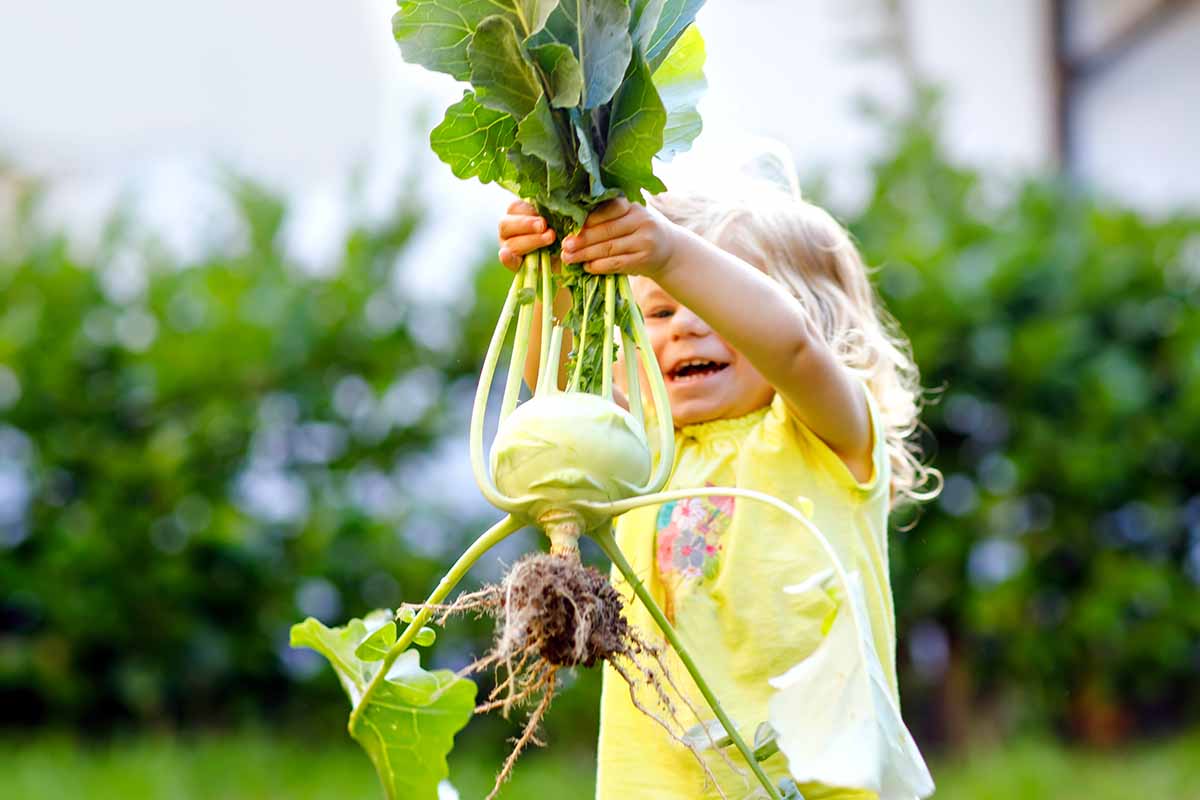
But it’s even more enjoyable to pick and eat kohlrabi, especially if you do it in a timely fashion.
Remember, kohlrabi doesn’t change color or otherwise in outward appearance to indicate that it’s ready to pick, so you’ll need to harvest based on the size of the swollen stems.
You can start picking when the stem globes are an inch in diameter.
Most cultivars taste best when they’re between one and three inches across, but make sure to check your seed packet or catalog for the anticipated size and expected number of days to maturity.
Mark the first possible maturity date on your calendar or in your gardening journal, or set a text reminder on your phone to start evaluating the globes for potential harvest that day.
Some cultivars, like the hybrid ‘Kossak,’ have been bred to reach peak quality at eight inches in diameter, but the majority of popular varieties will have a woody, tough texture if they grow too large.
You may need to water the soil the evening before harvest to make pulling easier.
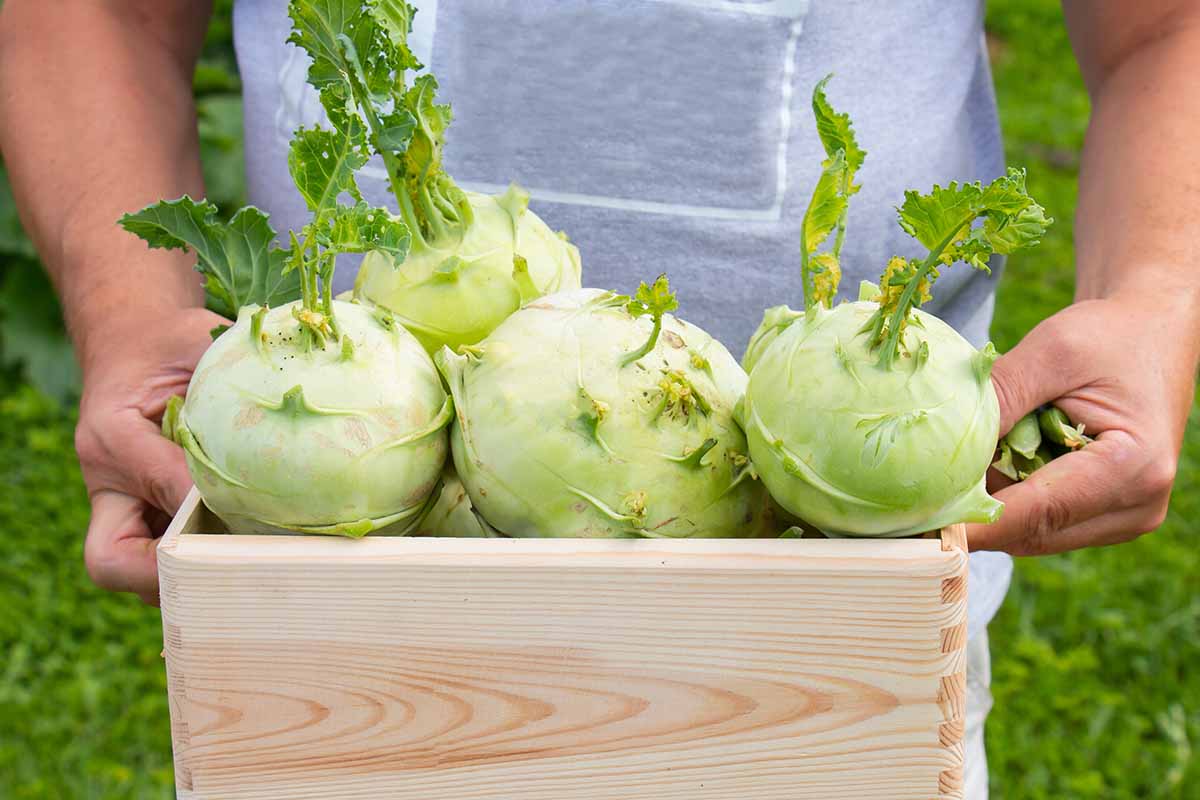
Either pull the whole plant from the ground or use a clean, sharp paring knife to slice the whole plant at the soil level. The roots can be composted or tilled into the soil.
Read more about harvesting kohlrabi here.
Some folks cook the leaf stems, but I think they’re too brittle and I usually relegate them to the compost.
You can also harvest kohlrabi greens earlier in the season to serve fresh in salads or braised as a side dish.
When you pick leaves early in the season, the “bulbs” on those plants won’t grow as large as those on plants left to grow with all of their leaves intact.
Like kale, the leaves are best with the tough, stemmy material – or “ribs” – removed.
You can keep the greens in the fridge for a couple of days. Only wash them right before cooking to discourage rotting.
Read more about harvesting and cooking kohlrabi greens here.
To store the dense, bulbous globes, cut off the spiny stems and place them in a resealable airtight plastic container or zipper bag in the fridge. They should stay fresh and crisp for two or three weeks.
With stems removed, kohlrabi also stores well in a root cellar, much like turnips, beets, rutabagas, and parsnips. They can be kept for up to three months in good condition.
Once you take kohlrabi out of the fridge or cold storage, you should wash it in cold water right before cooking.
Use a paring knife or vegetable peeler to remove the tough outer layer before using it in recipes.
Preserving
If you’re coping with a bumper crop, you can wash and peel kohlrabi, cut it into chunks or slices that suit your intended recipe, and blanch them in boiling water for three minutes.
Drain, then plunge them into ice water before draining again, and letting them air dry on a clean dish towel. Freeze in airtight containers.
Frozen kohlrabi can be thawed overnight in the fridge, drained, and cooked in your favorite recipes. Note that it won’t retain its fresh texture.
Kohlrabi is not a good candidate for canning, though you can shred peeled “bulbs” to make quick pickles.
Recipes and Cooking Ideas
Once you have a steady supply of homegrown kohlrabi, you can look forward to a wonderful variety of recipes that make the most of this crispy, crunchy, turnipy brassica.

Start with fried kohlrabi with cilantro yogurt sauce. Sure to become a family favorite, enjoy it as a main course for Meatless Monday dinner or as an appetizer whenever you’ve got fresh kohlrabi and hungry folks to share with.
Get the recipe on our sister site, Foodal.
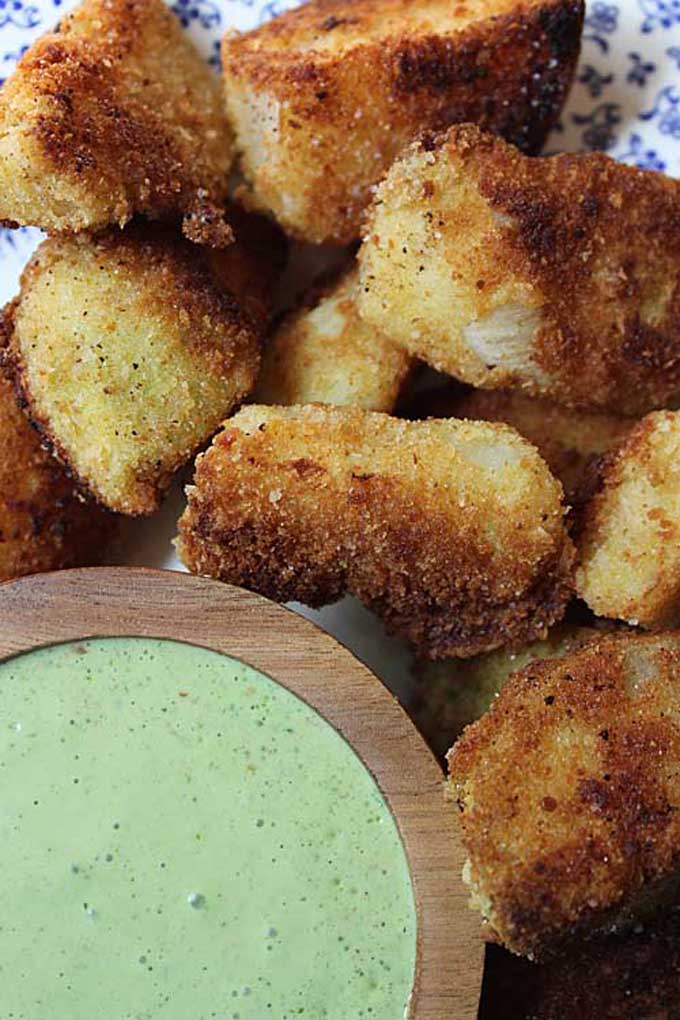
Kids might prefer the chunks with plain old ketchup, but feel free to experiment with other dipping sauces for more sophisticated palates.
For a quick side dish, especially to serve with braised pork or fried fish in autumn, try a spiralized kohlrabi slaw. Get the recipe now on Foodal.
The vegans (or vegan-curious) in the family will appreciate it when you use part of your harvest to make a vegan cream of kohlrabi soup concocted with sweet caramelized onions and coconut milk.
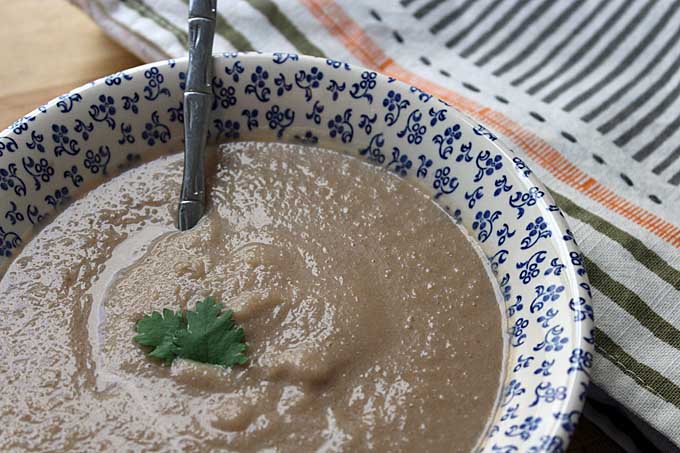
Serve small cups of this vegan delight as an appetizer at your next house party or potluck, or treat everyone to bowls at lunch. It’s delicious with whole grain bread for a healthy autumn meal. Get the recipe on Foodal now.
Quick Reference Growing Guide
| Plant Type: | Biennial cruciferous vegetable grown as an annual | Maintenance: | Low |
| Native to: | Northern Europe | Tolerance: | Frost, moderate freezes |
| Hardiness (USDA Zones): | 2-11 | Soil Type: | Loam amended with organic matter |
| Season: | Spring, fall, early winter | Soil pH: | 6.0-7.0 |
| Exposure: | Full sun | Soil Drainage: | Well-draining |
| Time to Maturity: | 45-70 days, depending on variety | Attracts: | Bees and other pollinators (flowers) |
| Spacing: | 2-12 inches | Companion Planting: | Beans, beets, celery, chamomile, chives, dill, nasturtiums, rosemary, sweet alyssum, thyme, turnips |
| Planting Depth: | 1/2 inch (seeds), even with soil surface (transplants) | Avoid Planting With: | Black walnut trees, corn, cucumber, eggplant, other brassicas like broccoli and kale, peppers, pumpkins and other squash, strawberries, tomatoes |
| Height: | 12-18 inches, depending on variety | Order: | Brassicales |
| Spread: | 4-12 inches | Family: | Brassicaceae |
| Growth Rate: | Fast | Genus: | Brassica |
| Water Needs: | Moderate | Species: | Oleracea |
| Common Pests and Diseases: | Aphids, cabbage loopers, cabbage worms, cutworms, deer, flea beetles, rabbits, slugs, snails; bacterial rot, damping off, downy mildew, root rot | Variety: | Gongylodes |
Kohlrabi’s Kind of Cute, and Very Tasty
Even more than the fun of planting vegetables with unusual shapes or colors, I simply enjoy being able to grow my own food.
Happily, I can harvest kohlrabi bulbs at several stages and eat the greens, too – and admire its quirky appearance all the while.
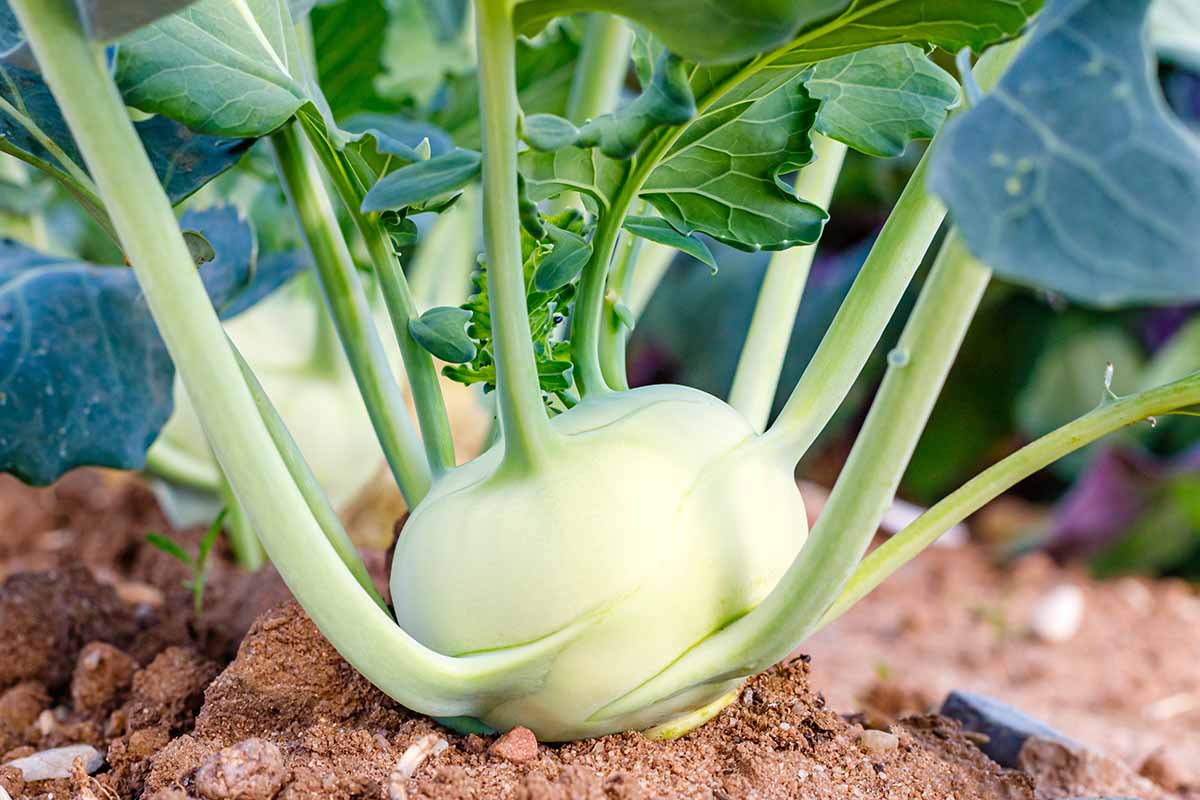
Are you going to plant this unusual brassica this fall or spring? If so, would you prefer a purple or green variety? Or are you one of the gardeners who’s already discovered the wonders of kohlrabi?
No matter your experience level, feel free to share some details in the comments section below, or ask any questions you have about this guide.
And for more information about growing kohlrabi in your garden, check out these guides next:

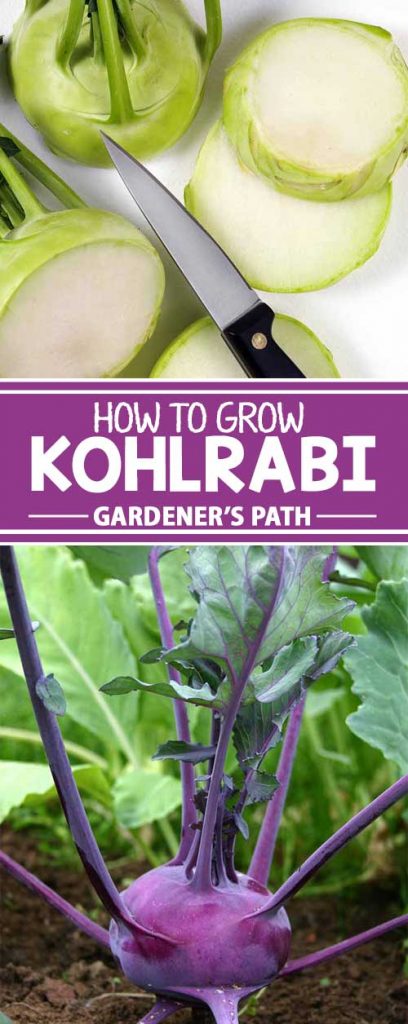
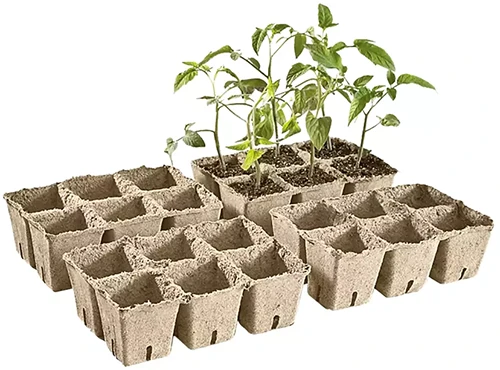
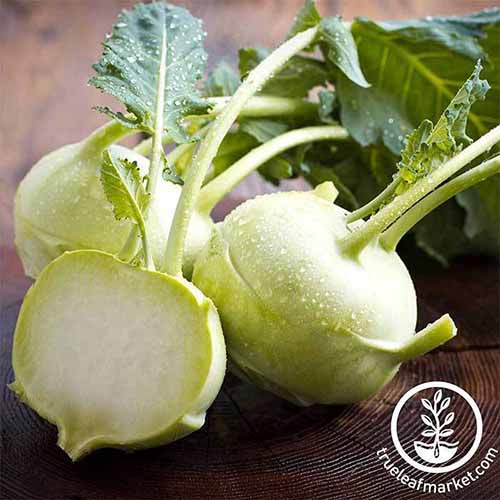
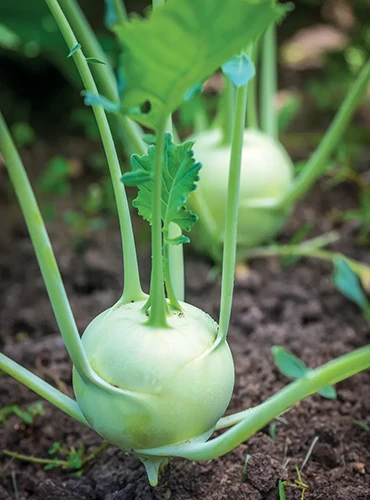
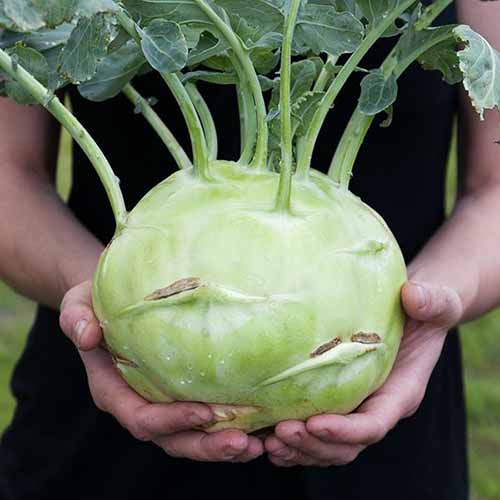
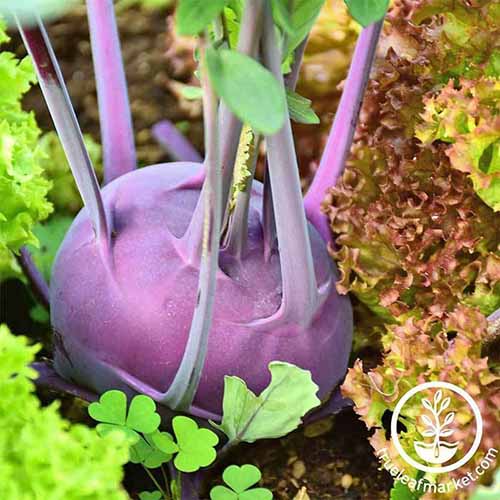
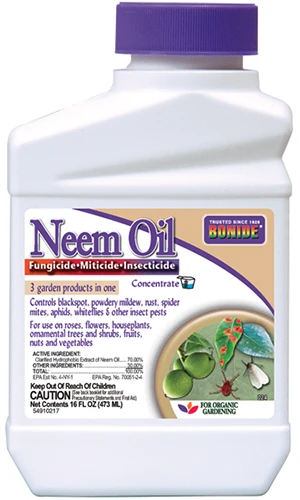



Boo Hoo(sob sob) Our Kohlrabi is in flower with tall stem and yellow flowers, very pretty but of the 6, which we planted in 3 gal. planters (to protect from the gopher varmints) none of them produced a bulb, so far. Do we leave in the buckets for longer? This is San Diego,CA, and early March is the tail end of our winter garden. HELP.
Do you have each of these growing individually in its own planter, or are all six plants growing in one 3-gallon container? A variety of factors can stress kohlrabi plants and cause them not to bulb, including overwatering or drought, lack of sunlight, too much nitrogen in the soil, and overcrowding. Providing 18 inches of space between these plants is recommended, and they need well-draining, fertile soil. Since this is a cool-weather crop, it can be more difficult to grow in southern locations with warmer climates. A sudden cold snap can lead to flowering, and unfortunately your plants won’t produce… Read more »
I have heard you can regrow a kohlrabi from the root end. Is this true? If so how do you do so? Or is there a better way to regrow a kohlrabi? Thank you.